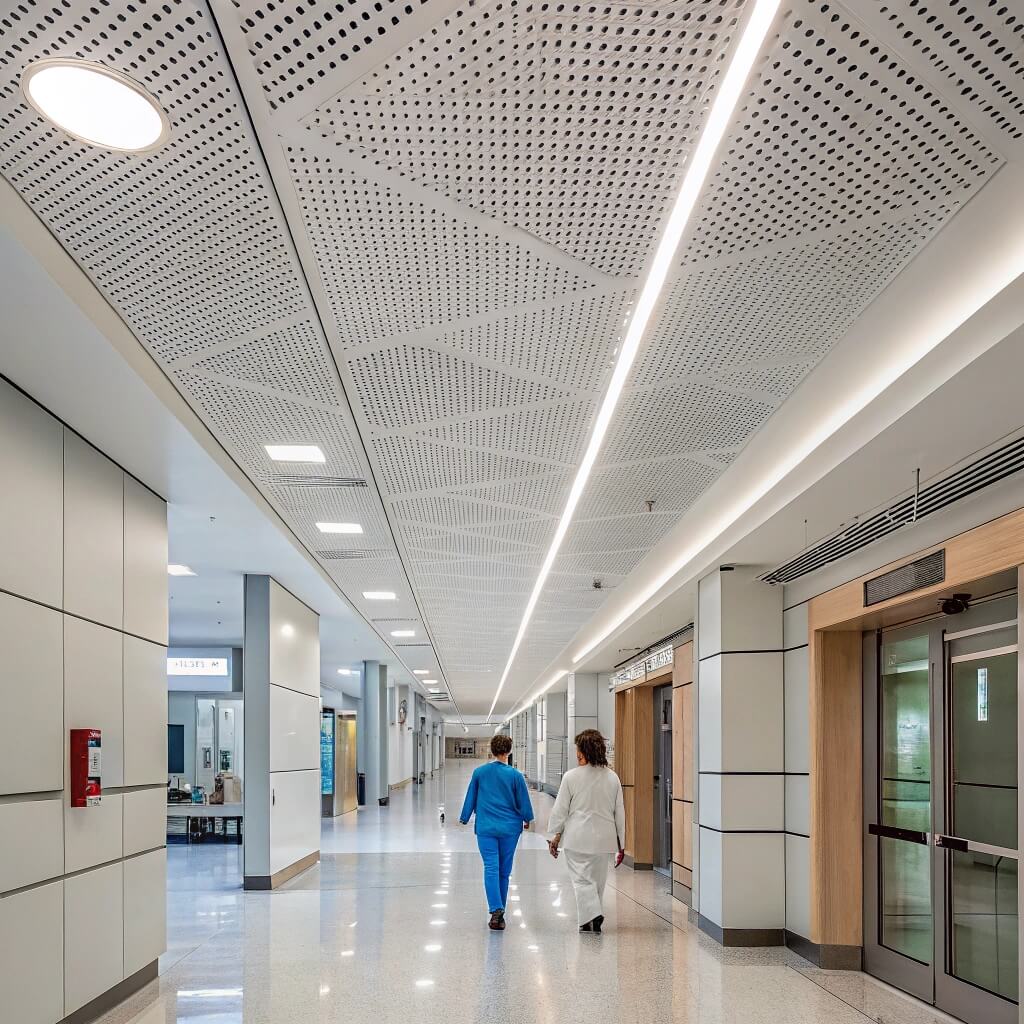What is an aluminum ceiling?

Many contractors waste time and money on ceilings that fail to last or match project needs. Poor choices lead to rework and frustrated clients.
An aluminum ceiling is a lightweight, fireproof, and corrosion-resistant ceiling system made from aluminum panels, often used in commercial or architectural interiors.
Aluminum ceilings are increasingly popular in modern architecture. They offer long-term durability and a clean look. But what makes them different from other materials? Let’s break it down.
What is an aluminium ceiling?
Many people confuse aluminum ceilings with metal sheets or simple paneling. Without clear knowledge, they may end up choosing the wrong ceiling system.
An aluminium ceiling refers to ceiling panels made from aluminum alloy, designed for both function and aesthetics in indoor and outdoor spaces.

Aluminum ceilings are common in airports, malls, schools, hospitals, and office buildings. The reason is simple. Aluminum is light, strong, and doesn’t rust. It’s also easy to install and remove, which helps with maintenance and repairs.
These ceilings come in many forms. They can be flat or curved, perforated or solid. They also support custom shapes and finishes. At Sinoextrud, we offer powder-coated, anodized, and woodgrain options.
Main Benefits of Aluminum Ceilings
| Feature | Advantage |
|---|---|
| Lightweight | Easy to install |
| Corrosion-resistant | Ideal for humid or coastal areas |
| Fire-resistant | Safe for public spaces |
| Customizable Design | Supports architects’ creativity |
| Easy Maintenance | Panels can be removed individually |
Aluminum ceilings are also sustainable. Most are made from recycled materials and are 100% recyclable. This makes them a smart choice for green buildings.
What are the three types of ceilings?
When choosing ceilings, many buyers only focus on appearance. But structure, function, and location matter just as much.
The three main types of ceilings are conventional ceilings, suspended ceilings, and exposed ceilings, each serving different design and utility purposes.

Each type has its pros and cons. Let’s explore them:
1. Conventional Ceiling
This is the typical flat ceiling made with plaster or gypsum board. It’s commonly used in homes and small offices.
2. Suspended Ceiling (Drop Ceiling)
This type hangs below the structural ceiling. It creates space to hide wires, pipes, or HVAC systems. Aluminum ceilings usually fall into this category.
3. Exposed Ceiling
In this design, the building’s structure (like beams or ducts) is visible. It gives a modern, industrial look. Often used in trendy cafes or loft offices.
Comparison Table
| Ceiling Type | Key Material | Usage Area | Advantages |
|---|---|---|---|
| Conventional | Gypsum/Plaster | Homes, Apartments | Cost-effective, simple |
| Suspended (Drop) | Aluminum/Metal Grid | Offices, Malls | Hides services, easy access |
| Exposed | None (Structural) | Cafes, Lofts | Industrial look, open space |
As a ceiling manufacturer, I help clients choose based on location, budget, and design goals. Aluminum ceilings fit best in suspended systems, where function meets aesthetics.
What is a metal strip ceiling?
Many designers love the look of sleek lines, but struggle to find ceiling solutions that combine beauty with function.
A metal strip ceiling uses long, narrow panels or “strips” made from aluminum or steel, installed in linear patterns for a clean, modern finish.

These ceilings are also called linear ceilings. They’re common in airports, train stations, and commercial lobbies. The key is their modularity. Strips come in different widths and depths. They can be flat or curved, solid or perforated.
At Sinoextrud, we produce strip ceilings in standard and custom profiles. Clients choose them for:
- Fast installation
- Easy maintenance
- Visual continuity
Types of Metal Strip Ceilings
- Plain Strips – For a smooth ceiling look.
- Perforated Strips – For better acoustics.
- Curved Strips – For dynamic, wave-like designs.
- Clip-in or Lay-in systems – Based on how panels are mounted.
This ceiling system suits clients who want flexibility and a modern design. Plus, it allows fast access to hidden ducts or cables behind the panels.
What are the two types of metal ceiling materials?
Many buyers think all metal ceilings are the same. But choosing the wrong material can lead to rust, discoloration, or even structural failure.
The two most common metal ceiling materials are aluminum and galvanized steel, each offering different benefits for durability, cost, and finish.

Aluminum
- Lightweight – Easy to transport and install
- Corrosion-resistant – Works well in wet or humid places
- Flexible design – Can be formed into many shapes
- Higher cost – But saves money on maintenance
Galvanized Steel
- Stronger and cheaper – Ideal for tight budgets
- Heavier – Needs stronger support structures
- Prone to rust – Needs coating or paint for protection
- Less flexible – Harder to shape into curves
Material Comparison
| Feature | Aluminum | Galvanized Steel |
|---|---|---|
| Weight | Very light | Heavy |
| Corrosion Resistance | Excellent (naturally) | Moderate (needs coating) |
| Price | Higher | Lower |
| Customization | Easy to bend and shape | More limited |
| Finish Options | Anodizing, Powder Coating | Paint, Powder Coating |
In my experience, aluminum is the better choice for most architectural projects. It’s cleaner, lasts longer, and offers more design freedom. I always guide clients to select the best material based on their climate, budget, and style goals.
Conclusion
Aluminum ceilings offer flexibility, durability, and style for modern architecture. They come in many forms, like strip and suspended systems, and outperform other metal options in most cases.


